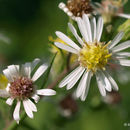Comments
provided by eFloras
Varieties of Symphyotrichum lanceolatum are sometimes grouped into two subspecies: subsp. hesperium (var. hesperium) and subsp. lanceolatum (the other four varieties). J. C. Semple and J. G. Chmielewski (1987) provided maps of the five taxa. The ranges of var. hesperium and var. lanceolatum overlap in the prairies and in the boreal zone from Alberta to the Clay Belt of northern Ontario. The ranges of the other three varieties do not overlap with that of var. hesperium, but they all overlap each other and with var. lanceolatum in the Midwest. The ecology and cytogeography of the species were summarized by Chmielewski and Semple (2001). The name Aster tradescantii has sometimes been misapplied to this species.
- license
- cc-by-nc-sa-3.0
- copyright
- Missouri Botanical Garden, 4344 Shaw Boulevard, St. Louis, MO, 63110 USA
- bibliographic citation
- Flora of North America Vol. 20: 466, 467, 469, 475, 477, 501, 509, 516, 517 in eFloras.org, Missouri Botanical Garden. Accessed Nov 12, 2008.
- source
- Flora of North America @ eFloras.org
- editor
- Flora of North America Editorial Committee
- project
- eFloras.org
Description
provided by eFloras
Perennials, 30–150(–200) cm, colonial; long-rhizomatous (rhizomes usually white, thick, contorted). Stems 1, erect (straight, stout), glabrous or hairy. Leaves thin, scabrous, apices mucronate, abaxial faces glabrous (vein areoles indistinct, elongate), adaxial glabrous or sparsely scabrous (var. hesperium); basal withering by flowering, petiolate to subpetiolate (petioles winged, ciliate, bases dilated, sheathing), blades elliptic-oblanceolate or obovate to suborbiculate, 10–80 × 5–20 mm, cuneate to attenuate, margins crenate-serrate, apices acute to obtuse or rounded; proximal cauline withering by flowering, sessile or subsessile, blades lance-ovate or oblanceolate to linear-lanceolate, (40–)50–150 × (3–)10–20(–35) mm, progressively reduced distally, bases cuneate, ± decurrent, margins serrate, apices acute to acuminate; distal sessile, blades oblanceolate to linear, 30–100(–140) mm, only slightly reduced distally, bases cuneate, margins entire. Heads in ample or diffuse to narrow, elongate, leafy, paniculiform arrays, branches ± ascending, rarely secund, branch leaves often longer than pedicels. Peduncles 0.5–5 cm, ± pilose, bracts 1–3(–5), linear-oblanceolate to -lanceolate, foliaceous, ciliate. Involucres campanulate to cylindric, 3–8 mm. Phyllaries in (3–)4–6 series, appressed or slightly spreading, linear-lanceolate to linear (innermost), sometimes slightly dilated distally, ± strongly unequal to subequal (var. hesperium), bases indurate 1 / 4 – 1 / 2 , margins scarious, erose, hyaline, sparsely ciliolate, green zones lanceolate to linear-lanceolate, outer sometimes foliaceous (particularly var. hesperium), apices acute to acuminate (outer) or acuminate to caudate (inner), mostly mucronulate, abaxial faces glabrous, adaxial sparsely strigillose. Ray florets 16–50; corollas white to pinkish or pale blue-violet, laminae 3–10(–14) × 0.5–1.3 mm. Disc florets (13–)20–40(–52); corollas yellow becoming purple, 2.8–5.8 mm, tubes shorter than funnelform throats, lobes sometimes ± spreading, triangular, 0.4–1.2 mm. Cypselae gray or tan, obovoid, ± compressed, 1.5–2 mm, 4–5-nerved, faces sparsely strigillose; pappi white to sordid or tawny, 5.5–6 mm.
- license
- cc-by-nc-sa-3.0
- copyright
- Missouri Botanical Garden, 4344 Shaw Boulevard, St. Louis, MO, 63110 USA
- bibliographic citation
- Flora of North America Vol. 20: 466, 467, 469, 475, 477, 501, 509, 516, 517 in eFloras.org, Missouri Botanical Garden. Accessed Nov 12, 2008.
- source
- Flora of North America @ eFloras.org
- editor
- Flora of North America Editorial Committee
- project
- eFloras.org
Synonym
provided by eFloras
Aster lanceolatus Willdenow, Sp. Pl. 3: 2050. 1803
- license
- cc-by-nc-sa-3.0
- copyright
- Missouri Botanical Garden, 4344 Shaw Boulevard, St. Louis, MO, 63110 USA
- bibliographic citation
- Flora of North America Vol. 20: 466, 467, 469, 475, 477, 501, 509, 516, 517 in eFloras.org, Missouri Botanical Garden. Accessed Nov 12, 2008.
- source
- Flora of North America @ eFloras.org
- editor
- Flora of North America Editorial Committee
- project
- eFloras.org

